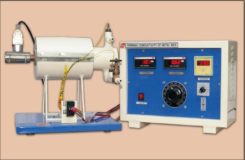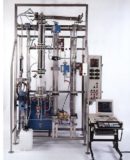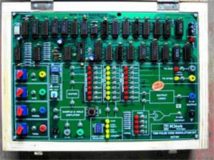Multi-Pass Floating Heat Exchanger Cutaway Model THC 003
Home » Products » Multi-Pass Floating Heat Exchanger Cutaway Model THC 003
Multi-Pass Floating Heat Exchanger Cutaway Model THC 003
– Made in fully transparent acrylic allowing study of internal/external construction
– Working model through which liquids/gasses can be passed
– Durable and easily cleanable model
– Offered in durable 1” foam coated wooden case
Item Description
Heat exchangers connected in series and parallel arrangements to exchange heat between several hot and cold streams form a heat exchanger network. When the method of connecting is predominantly in series the network is often called a multistage heat exchanger system.
PRINCIPLE MULTI- PASS HEAT EXCHANGER:
– The heat transfer coefficient of tube side and shell side fluid is very important and the individual heat transfer coefficients must be high enough to attain high overall heat transfer coefficient. As the shell would be quite large as compared to the tubes, the velocity and the turbulence of the shell side fluid is important.
– In contrast, the multi pass heat exchanger has limitations also. When the tube side flow is divided evenly among all the tubes, the velocity may be quite low, resulting in low heat transfer coefficient. There it may be required to increase the area to have the desired heat exchange for this low heat transfer coefficient.
– The area may be increased by increasing the length of the tube. However, the tube length requirement may be impractical for a given situation. Thus the number of tubes should be increased without increased the tube length.
– The increased number of tubes would also provide the increased velocity in the shell side resulting in the higher heat transfer coefficient. Therefore, multi-pass construction is needed, which would permit to use the practical and standard tube lengths.
Technical Specifications
– The simplest type of heat exchangers is double pipe heat exchangers, which is inadequate for flow rates that cannot readily be handled in a few tubes. If several double pipes are used in parallel, the metal weight required for the outer tubes becomes so large that the shell and tube construction, such as multi pass heat exchanger will be helpful. In that one shell serves for many tubes, is economical.
– Such systems have diverse industrial applications, a frequent application being the pre-heating of petroleum crude in refineries. Several different size combinations of individual heat exchangers in a multistage system can satisfy the overall system requirement
– That is that of heating a specified main fluid stream from a given initial temperature to a required final temperature. Usually only one particular combination will lead to a minimum total system size or system cost. The method for discovering this combination is the task undertaken in the present work.
– The present work is not concerned with the detailed design of an individual heat exchanger in a system. Rather, the present work is concerned with additional considerations that arise when individual heat exchangers are connected to form a multistage system.
– Commonly, the multi-pass heat exchanger reverses the flow in the tubes by use of one or more sets of “U” bends in the tubes. The “U” bends allow the fluid to flow back and forth across the length of the heat exchanger.
– A second method to achieve multiple passes is to insert baffles on the shell side of the heat exchanger. These direct the shell side fluid back and forth across the tubes to achieve the multi-pass effect.
See also different:

Sci-tech Thermal Conductivity of Metal Bar Apparatus Model TH 007 explains practically that thermal conductivity is a physical property of material denoting the ease with a particular substance can accomplish the transmission of thermal energy [...]



